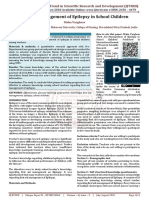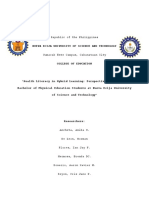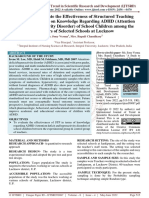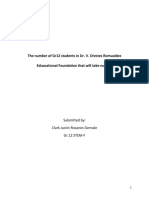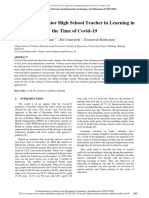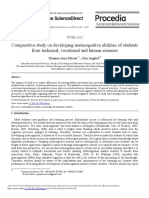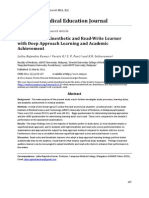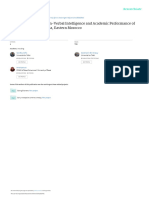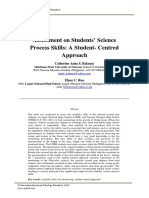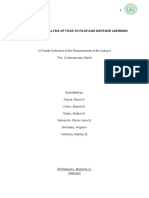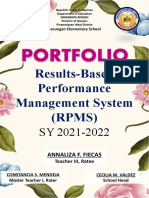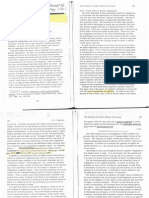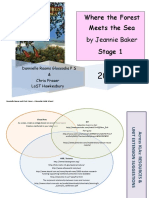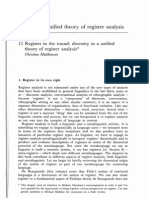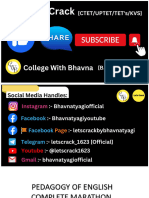Professional Documents
Culture Documents
Perceived Impact of Active Pedagogy in Medical Students' Learning at The Faculty of Medicine and Pharmacy of Casablanca
Perceived Impact of Active Pedagogy in Medical Students' Learning at The Faculty of Medicine and Pharmacy of Casablanca
Original Title
Copyright
Available Formats
Share this document
Did you find this document useful?
Is this content inappropriate?
Report this DocumentCopyright:
Available Formats
Perceived Impact of Active Pedagogy in Medical Students' Learning at The Faculty of Medicine and Pharmacy of Casablanca
Perceived Impact of Active Pedagogy in Medical Students' Learning at The Faculty of Medicine and Pharmacy of Casablanca
Copyright:
Available Formats
Volume 9, Issue 4, April – 2024 International Journal of Innovative Science and Research Technology
ISSN No:-2456-2165 https://doi.org/10.38124/ijisrt/IJISRT24APR278
Perceived Impact of Active Pedagogy in Medical
Students' Learning at the Faculty of Medicine and
Pharmacy of Casablanca
Dr. Adelin Niyonsaba1*; Espoir Irakoze2; Amal Barkouk1; Fatima Zahra Mouzoun1; Zineb Boubekri1; Hind Berrami1
Nouha Belayachi1; Manar Jallal3; Zineb Serhier4,5; Mohammed Bennani Othmani6
1
Medical Informatics Department/20 August 1953 Hospital/ Ibn Rochd University Hospital Center / Hassan II University,
Casablanca, Morocco
2
Cardiovascular Surgery Department/Ibn Rochd University Hospital Center/Hassan II University, Casablanca, Morocco
3
Medical Informatics Department/20 August 1953 Hospital, Hassan II University/Faculty of Medicine and Pharmacy/ Ibn Rochd
University Hospital Center, Casablanca, Morocco
4
Laboratory of Medical Informatics, Hassan II university, Casablanca, Morocco
5
Clinical Neuroscience and Mental Health Laboratory, Hassan II University, Casablanca, Morocco
6
Clinical Neuroscience and Mental Health Laboratory, Faculty of Medicine and Pharmacy, Hassan II University, Ibn Rochd
Hospital, Casablanca, Morocco
Corresponding Author:- Dr. Adelin Niyonsaba1*
Abstract:- recognized the benefits of active pedagogy: it increases
educational performance (86.8%) and engagement
Background: (77.7%), helps succeed in evaluations (80.4%), boosts
Learning through active methods is recognized for motivation (80%), fosters autonomy (79.5%), and
facilitating material assimilation, increasing motivation, prepares for professional life according to 81.3% of
improving performance, and fostering autonomy among students. Over 82% of students favored replacing
medical students. Despite these advantages, some traditional pedagogy with active pedagogy.
difficulties persist for certain students, and traditional
teaching methods continue to dominate in medical Conclusion:
faculties. Active methods are highly appreciated by medical
students for their ability to promote autonomous
Objective: learning and high educational performance. However,
This study aims to describe the viewed impact of despite their satisfaction, these methods remain
active pedagogy methods and students' perception underutilized, and some students still encounter
towards them. difficulties. The majority of students support their
generalization as a replacement for traditional methods.
Population and Methods:
A cross-sectional study was conducted among Keywords:- Active pedagogy, Learning, Medical Students,
medical students at the Faculty of Medicine and Impact, Satisfaction.
Pharmacy of Casablanca in November and December
2023. The sample size was calculated using Epi Info I. INTRODUCTION
7.2.5.0 software, and probabilistic sampling was used to
determine our sample. Data were collected using an During the 1980s, a desire to reform higher education
electronic questionnaire (Google Forms) containing teaching methods emerged, aiming to transition from
questions about the impact and perception of active traditional approaches where professors speak and students
pedagogy, then processed and analyzed using R software passively listen, to active methods involving students in
while maintaining confidentiality and data protection. their learning, known as "Active Pedagogy" (1,2). Despite
this intent, traditional methods persist in many universities
Results: (3).
Out of a total of 442 students who were mostly
female (57.2%), a large portion (83.0%) were unfamiliar Active pedagogy emphasizes the active involvement of
with the concept of active pedagogy. However, the most students in their learning through interactive, collaborative,
well-known active pedagogy methods were simulation, and practical methods that promote engagement, skill
practical and directed work, and clinical cases among acquisition, autonomy, and student performance (4). Active
54.0% of students, role-playing, group work, and Pedagogy engages students in high-level thinking (analysis,
presentations among 44.2%, as well as e-learning among synthesis, evaluation) and concrete activities (reading,
32.7%. The results showed that the majority of students
IJISRT24APR278 www.ijisrt.com 551
Volume 9, Issue 4, April – 2024 International Journal of Innovative Science and Research Technology
ISSN No:-2456-2165 https://doi.org/10.38124/ijisrt/IJISRT24APR278
discussion, writing, practice) to explore their attitudes and III. RESULTS
values (3,5).
In our sample of 442 students, the mean age was 20.4
Several methods of active pedagogy are grouped under years (±1.8 SD) with a female predominance of 57.2%. In
four principles: experimental, socio-collaborative, problem- terms of year of study, there was a slight predominance of
based, and project-based learning (6). These methods, such the 5th year (21.9%), while the other years were almost
as online teaching, case studies, role-playing, debates, evenly distributed between 13.8% for the 6th year and
simulations, group learning, peer teaching, etc., positively 17.4% for the 1st year.
influence student attitudes, interactions, and results (3). A
recent study in the United States has shown that active The majority of students (83.0%) were unaware of the
pedagogy methods improve knowledge retention compared concept of active pedagogy, while 17.0% claimed to be
to traditional methods, particularly in specific areas such as familiar with it. The most well-known active pedagogy
Advanced Pharmacy Practice Experiences (APPE) in methods were dominated by Simulations, practical work,
pharmacy (7). directed work and clinical cases known by 54.0% of
students, followed by role-playing, group work and
However, the adoption of these methods has presentations by 44.2% of students, then e-learning by
encountered challenges such as student engagement, 32.7%. Flipped classroom was the least known, mentioned
managing classroom distractions, and institutional and by only 11.4% of students.
logistical barriers (3). Obstacles to the adoption of these
methods include the persistent influence of traditional Our study revealed that most students used summaries,
methods, teacher reluctance, anxiety about change, worksheets and mind maps for learning, accounting for
increased preparation time, and lack of resources (3). 86.7% of students, with self-directed learning and
Despite these challenges and obstacles, various methods of reflections following closely at 74.0% and e-learning being
active pedagogy are applied in medical education in utilized by 69.9% of students. The flipped classroom
Casablanca while the traditional method persists. teaching method was ranked last, with only 5.4% of students
using it. (Figure 1)
The objective of this study is to describe the viewed
impact of active pedagogy methods and to specify students'
perceptions towards them.
II. POPULATION AND METHODS
This is a descriptive cross-sectional study conducted in
November and December 2023, including students from the
Medicine program at the Faculty of Medicine and Pharmacy
of Casablanca from the 1st to the 6th year.
The sample size calculation was performed using Epi
Info 7.2.5.0 software, based on the assumption that 50% of
students admitted that active pedagogy has an impact on
their learning, given the absence of any previous studies on
this subject. Using a precision of 5%, we obtained a
necessary sample size of at least 341 students. Then, we
conducted a probabilistic cluster sampling stratified
according to the years of study.
Data were collected using an electronic Google Forms
questionnaire, which was shared in practical work or
directed work groups for pre-clinical students and in Fig 1 Active Pedagogy Methods used by Medical
internship groups for clinical-stage students. The Students in Casablanca (% of Students)
questionnaire included the study of sociodemographic
characteristics, the impact of active pedagogy on learning Overall, our study found that the number of students
according to students, as well as their perception and dissatisfied with current teaching methods (47.8%) greatly
recommendations on the subject. exceeded the number of those who were satisfied (12.2%);
while 40.0% of students preferred to remain neutral.
Data analysis was conducted using R software version
4.3.2, which allowed for calculating means (with standard The majority of students affirmed that active pedagogy
deviation) and frequencies. Data collection and processing methods have a beneficial effect on their learning.
were carried out in compliance with confidentiality and data According to 86.8% of students, they increase their
protection regulations specific to participants. educational performance, while 77.7% claim they improve
their engagement and involvement. Also, 87.3% admitted
IJISRT24APR278 www.ijisrt.com 552
Volume 9, Issue 4, April – 2024 International Journal of Innovative Science and Research Technology
ISSN No:-2456-2165 https://doi.org/10.38124/ijisrt/IJISRT24APR278
that they facilitate understanding and mastery of the course, time to adapt to active methods, 51.4% reported having
while 77.5% admitted that they develop their social skills difficulties applying these methods, and 40.8% of them
and sense of teamwork. Additionally, 87.5% judged that highlighted inequality among learners. (Figure 2)
they stimulate creativity and critical thinking, 80.4% stated
that they help them succeed in evaluations, and 80.0%
agreed that active pedagogy facilitates understanding of new
concepts. (Table 1)
Table 1 Perceived Impact of Active Pedagogy
According to Medical Students
Fig 2 Types of Difficulties Associated with Active
Pedagogy (% of Students)
The study also found that active pedagogy increases Our study found a statistically significant association
motivation and enthusiasm in nearly 80.0% of students, between the presence of difficulties and the willingness to
develops autonomy in learning according to 79.5%, but also replace traditional methods with active pedagogy (p =
allows for the construction of coherent projects according to 0.005). There was also a significant association between the
68.6% of students. (Table 1) year of study and difficulties during active pedagogy
sessions (p = 0.00004), with a decrease in difficulties as the
Regarding students' perception of currently applied course progressed.
active pedagogy methods for their learning, only 22.5%
believed that student-teacher interactions were sufficient and The vast majority of students (82.7%) were in favor of
effective. Almost half of them (49.2%) considered that replacing traditional teaching methods with active
active pedagogy helps identify their strengths and pedagogy, while 10.0% of students favored hybrid learning
weaknesses, and 23.4% admitted that the materials used are combining both types of teaching to benefit maximally and
suitable. The pace of classes was considered appropriate, ensure complete and quality learning. It is noteworthy that a
and teaching was clear and precise according to 27.5% of significant proportion of students (7.3%) favored
students. The way information was conveyed was maintaining traditional pedagogy and considered it effective
motivating according to 30.2% of students, the feedback and sufficient for ensuring good learning. A great proportion
received was relevant for 26.8% and 81.3% of them of students (88.1%) suggested wide introduction of active
believed that their professional life as clinicians would be pedagogy methods in the teaching program, and 85.6% of
enhanced through active pedagogical methods. students preferred to have active pedagogy sessions after
lectures.
Compared to traditional pedagogy, which can, in some
cases, slow down or make learning more difficult, students Most students (88.4%) wished for active pedagogy
pointed out numerous benefits of embracing active sessions to be supervised by qualified teachers from the
pedagogy, with the primary ones being efficiency and early years of study. They suggested avoiding questions of
enhanced performance cited by 56.3% of respondents. simple information retrieval, and 86.8% of them wanted to
Additionally, 33.3% of students emphasized its role in be able to specify in advance any form of preparatory work
stimulating productivity, motivation, and fostering student before discussion sessions (readings, research, prerequisites,
autonomy, while 20.0% highlighted its facilitation of etc.). Almost all students (90.2%) expressed their
learning with ease and speed. willingness to adhere to scheduling active pedagogy
sessions according to their availability despite time
The majority of students (65.0%) did not encounter constraints and busy schedules, and 87.9% of students were
difficulties with active pedagogy methods in their learning, in favor of spreading active pedagogy techniques.
while 35.0% reported having difficulties. Among the
difficulties cited, 54.3% of students indicated needing more
IJISRT24APR278 www.ijisrt.com 553
Volume 9, Issue 4, April – 2024 International Journal of Innovative Science and Research Technology
ISSN No:-2456-2165 https://doi.org/10.38124/ijisrt/IJISRT24APR278
IV. DISCUSSION About half of the students (49.2%) admitted that active
pedagogy helps them identify their strengths and
Our study revealed a significant number of students weaknesses. In comparison, a study in the UAE in 2021
(83.0%) unaware of the concept of active pedagogy, while a demonstrated that 75.0% of students agreed that active
minority of 17.0% claimed familiarity. This result could be pedagogy enables students to identify their strengths and
attributed to a gap in academic programs that do not weaknesses (12).
adequately address this educational approach.
Our study revealed a statistically significant
Most students confirmed a positive impact of active association between difficulties and preference for active
pedagogy on various aspects of their learning, with 86.8% pedagogy (p = 0.005). Students without difficulty (65.0%)
stating that it enhances their educational performance. These favored transitioning to this method, while students with
results align with findings from a study conducted in the difficulties (35.0%) preferred hybrid or traditional teaching.
United Arab Emirates in 2018 (4). Similarly, another study The year of study was also linked to difficulties in active
in Pennsylvania, USA (2004), found that 90.0% of students pedagogy (p = 0.00004), with an increase in familiarity
reported that active methods facilitate understanding and among students as they progressed in their curriculum.
assimilation of basic concepts in their studies (6).
A large majority of students (88.1%) were in favor of a
Over 80.0% of students affirmed that active pedagogy broader introduction of active pedagogy methods into their
methods help them succeed in evaluations and facilitate their program. Similarly, 85.6% of students recommended
understanding of new concepts. This result resembles the planning lectures before active pedagogy sessions, and
findings in a study conducted in Ohio, USA in 2007 (8). 87.9% expressed a desire to participate in active pedagogy
sessions. Likewise, in the same 2021 UAE study, 85% of
According to 77.7% of students, active methods students expressed their desire to have access to active
increase their engagement and involvement in learning. This pedagogy sessions in the future (12).
supports the findings of previous studies conducted in Ohio,
USA (2007) and the United Arab Emirates (2018). (4,8). Finally, 82.7% of students were in favor of replacing
Similarly, in another study in the United Kingdom in 2021, traditional pedagogy with active pedagogy, citing several
82.0% of students asserted that active learning had a advantages of the latter. 10.0% were in favor of hybrid
significant impact on their level of engagement (9). teaching combining traditional and active pedagogy, while
only 7.3% preferred maintaining traditional methods. In a
In our study, 77.5% of students attested that group study in Brazil 2019, 81.0% of students favored combining
work allows them to develop social skills within a positive traditional methods with teamwork learning (11). The
and inclusive group dynamic. According to the same study majority of students (86.8%) believed that specifying
conducted in the United Kingdom in 2021, 72.0% of preparatory work in advance was necessary. Similarly, in the
students agreed that collaborative methods enabled them to same study conducted in the UAE, 82.5% agreed with this
develop social skills while increasing their willingness to statement (12).
participate actively (9).
V. CONCLUSION
Only 23.4% of students admitted that the materials
used during active pedagogy sessions were suitable, and The study has highlighted the perceived positive
41.8% felt that the pace of sessions was not appropriate. In impact of active pedagogy on medical learning, despite the
Dijon, France (2015), a study showed, on the contrary, that difficulties experienced by some students in its adoption.
72.2% thought that the materials used were suitable; Variations in evaluations are attributed to students'
similarly, 75.1% felt that the pace of classes was appropriate expectations, their prior exposure to active methods, and
(10). This difference could be explained by the disparity in local educational standards. This finding underscores the
resources deployed in educational systems and the time need to adapt pedagogical approaches to better meet the
devoted to developing specific and adapted programs. specific needs of students.
Based on our study, only 30.2% of students found the While data on the use of these methods in Morocco are
transmission of information motivating. In contrast, 68.4% limited, encouraging experiences have shown promising
of students in a similar French study found it motivating. results. The reform of pedagogical practices should be
(10). Similarly, a study conducted in Brazil showed that initiated by teachers, who must devise active learning
most students were motivated during active learning strategies that suit them. These strategies should be well-
sessions (11). This gap between our results and the literature structured, planned, and focused on familiar subjects for
could be due to better teacher training through more recent both teachers and students.
programs, targeting weaknesses and addressing learners'
needs. The gradual integration of more active strategies into
traditional teaching is essential, supported by training for
teachers to facilitate this transition towards a more
participatory and interactive approach to medical education.
IJISRT24APR278 www.ijisrt.com 554
Volume 9, Issue 4, April – 2024 International Journal of Innovative Science and Research Technology
ISSN No:-2456-2165 https://doi.org/10.38124/ijisrt/IJISRT24APR278
ACKNOWLEDGEMENTS [10]. Duguet A. Perception des pratiques pédagogiques des
enseignants par les étudiants de première année
At the culmination of this work, we wish to express our universitaire et effets sur leur scolarité. Revue
gratitude to Mrs Odette NIZIGIYIMANA, Chanez Celia française de pédagogie Recherches en éducation. 30
I., Clery Maëllan I., Jovan Darel D. and Aby Buntu Elina sept 2015;(192) :73‑94.
G. for their encouragement and moral support. [11]. Rezende AB, de Oliveira AGF, Vale TC, Teixeira
LAS, Lima ARA, Lucchetti ALG, et al. Comparison
Our thanks are also extended to all the staff of the of Team-Based Learning versus Traditional Lectures
Medical Informatics Department at CHU Ibn Rochd (20 in Neuroanatomy: Medical Student Knowledge and
August 1953 Hospital) for their valuable guidance and Satisfaction. Anat Sci Educ. sept
contributions aimed at enriching this work. 2020;13(5):591‑601.
[12]. Eladl MA, Guraya SY. Measuring the Effectiveness
REFERENCES of Faculty Feedback on the use of an active
integrated instructional pedagogy for the embryology
[1]. Cross KP. Teaching for Learning [Internet]. Vol. 39, course. Journal of Taibah University Medical
AAHE Bulletin. 1987 [cité 18 janv 2024]. Disponible Sciences. 1 févr 2022;17(1):120‑7.
sur : https://eric.ed.gov/?id=ED283446
[2]. Involvement in Learning: Realizing the Potential of
American Higher Education. Final Report of the
Study Group on the Conditions of Excellence in
American Higher Education [Internet].
Superintendent of Documents, U; 1984 oct [cité 18
janv 2024]. Disponible sur:
https://eric.ed.gov/?id=ED246833
[3]. Bonwell CC, Eison JA. Active Learning: Creating
Excitement in the Classroom. 1991 ASHE-ERIC
Higher Education Reports [Internet]. ERIC
Clearinghouse on Higher Education, The George
Washington University, One Dupont Circle, Suite
630, Washington, DC 20036-1183 ($17; 1991 [cité
17 janv 2024]. Disponible sur:
https://eric.ed.gov/?id=ED336049
[4]. Javed Y, Odhabi H. Active Learning in Classrooms
Using Online Tools: Evaluating Pear-Deck for
Students’ Engagement. In: 2018 Fifth HCT
Information Technology Trends (ITT) [Internet].
2018 [cité 6 oct 2023]. p. 126‑31. Disponible sur :
https://ieeexplore.ieee.org/abstract/document/864951
5
[5]. Chickering AW, Gamson ZF. Seven Principles for
Good Practice in Undergraduate Education [Internet].
AAHE Bulletin. 1987 mars [cité 18 janv 2024].
Disponible sur : https://eric.ed.gov/?id=ED282491
[6]. Prince M. Does Active Learning Work? A Review of
the Research. Journal of Engineering Education. juill
2004;93(3):223‑31.
[7]. Lucas KH, Testman JA, Hoyland MN, Kimble AM,
Euler ML. Correlation Between Active-Learning
Coursework and Student Retention of Core Content
During Advanced Pharmacy Practice Experiences.
Am J Pharm Educ. 14 oct 2013;77(8):171.
[8]. Martyn M. Clickers in the Classroom: An Active
Learning Approach.
[9]. Munna AS, Kalam MA. Impact of Active Learning
Strategy on the Student Engagement. GNOSI : an
interdisciplinary journal of human theory and praxis.
2021 ;4(2) :96‑114.
IJISRT24APR278 www.ijisrt.com 555
You might also like
- Designing Teaching Strategies: An Applied Behavior Analysis Systems ApproachFrom EverandDesigning Teaching Strategies: An Applied Behavior Analysis Systems ApproachRating: 4.5 out of 5 stars4.5/5 (1)
- Teaching Strategies Promoting Active Learning in Healthcare EducationDocument14 pagesTeaching Strategies Promoting Active Learning in Healthcare EducationGlenn Asuncion Pagaduan100% (1)
- Internal External AlignmentDocument6 pagesInternal External AlignmentZebaNo ratings yet
- Understanding Doctoral Nursing Students' Experiences of Blended LearningDocument8 pagesUnderstanding Doctoral Nursing Students' Experiences of Blended LearningZilbran BerontaxNo ratings yet
- Blended Learning' As An Effective Teaching and Learning Strategy in Clinical Medicine: A Comparative Cross-Sectional University-Based StudyDocument6 pagesBlended Learning' As An Effective Teaching and Learning Strategy in Clinical Medicine: A Comparative Cross-Sectional University-Based StudyAnonymous GOUaH7FNo ratings yet
- First Aid Management of Epilepsy in School ChildrenDocument4 pagesFirst Aid Management of Epilepsy in School ChildrenEditor IJTSRDNo ratings yet
- Instructional Design and Assessment Vodcasts and Active-Learning Exercises in A "Flipped Classroom" Model of A Renal Pharmacotherapy ModuleDocument5 pagesInstructional Design and Assessment Vodcasts and Active-Learning Exercises in A "Flipped Classroom" Model of A Renal Pharmacotherapy Modulemtauhid20087888No ratings yet
- Investigation of Nursing Students Knowledge of and Attitudes About Problem Based LearningDocument4 pagesInvestigation of Nursing Students Knowledge of and Attitudes About Problem Based LearningasdasdasdasNo ratings yet
- Revised Chapter-1-3-GreatmatesDocument24 pagesRevised Chapter-1-3-GreatmatesJocelyn Sta AnaNo ratings yet
- The Effect of Blended Learning On Nursing Students' KnowledgeDocument4 pagesThe Effect of Blended Learning On Nursing Students' KnowledgeMahmud Ady YuwantoNo ratings yet
- Duarte 2022Document12 pagesDuarte 2022Juan Carlos FloresNo ratings yet
- Factors Affecting MetacognitionDocument9 pagesFactors Affecting MetacognitionZilbran BerontaxNo ratings yet
- 1982 0194 Ape 31 02 0162Document8 pages1982 0194 Ape 31 02 0162Shalini VermaNo ratings yet
- International Journal of Trend in Scientific Research and Development (IJTSRD)Document4 pagesInternational Journal of Trend in Scientific Research and Development (IJTSRD)Editor IJTSRDNo ratings yet
- Harden's Spices Model For Biochemistry in Medical CurriculumDocument10 pagesHarden's Spices Model For Biochemistry in Medical CurriculumGlobal Research and Development Services100% (1)
- Learning Styles and Academic Performance in Nursing Interns of A National University of PeruDocument8 pagesLearning Styles and Academic Performance in Nursing Interns of A National University of PeruElmer Yeder Cancan VasquezNo ratings yet
- Evaluation of Healthcare Science Student Learning Styles Based VARK Analysis TechniqueDocument7 pagesEvaluation of Healthcare Science Student Learning Styles Based VARK Analysis TechniqueInternational Journal of Evaluation and Research in Education (IJERE)No ratings yet
- Descriptive Study Implementation of Blended Learning During The Pandemic of UMS Undergraduate Pharmaceutical StudentDocument14 pagesDescriptive Study Implementation of Blended Learning During The Pandemic of UMS Undergraduate Pharmaceutical StudentgrevaldoNo ratings yet
- Perceptions of Students RegardDocument6 pagesPerceptions of Students RegardLina Mahayaty SembiringNo ratings yet
- 67 1468481336 PDFDocument9 pages67 1468481336 PDFRiana RurmanNo ratings yet
- Nursing EducationDocument6 pagesNursing EducationnishthaNo ratings yet
- The Number of Gr12 Students in Dr. V. Orestes Romualdez Eduacational Foundation That Will Take NursingDocument13 pagesThe Number of Gr12 Students in Dr. V. Orestes Romualdez Eduacational Foundation That Will Take NursingSimon VertulfoNo ratings yet
- Creativity of Junior High School Teacher in Learning in The Time of Covid-19Document4 pagesCreativity of Junior High School Teacher in Learning in The Time of Covid-19Abdilla AsriNo ratings yet
- Enhancing Occupational Therapy Students Knowledge, Competence, Awareness and Interest in AccessibilityDocument8 pagesEnhancing Occupational Therapy Students Knowledge, Competence, Awareness and Interest in Accessibilityying reenNo ratings yet
- 1 - Brain Based LearningDocument12 pages1 - Brain Based LearningFitri Esa Ulva MimaNo ratings yet
- Mentoring, Nursing Students' Opinions A Pilot StudyDocument7 pagesMentoring, Nursing Students' Opinions A Pilot StudyinventionjournalsNo ratings yet
- Effect of The Blended Learning Approach On Pupils Science Academic Performance in Eti-Osa Local Govt Area.Document45 pagesEffect of The Blended Learning Approach On Pupils Science Academic Performance in Eti-Osa Local Govt Area.Favour ChukwuelesieNo ratings yet
- Lectures in MedicineDocument5 pagesLectures in MedicineJhon Leonard FatalloNo ratings yet
- Comparative Study On Developing Metacognitive Abilities of Students From Technical, Vocational and Human SciencesDocument5 pagesComparative Study On Developing Metacognitive Abilities of Students From Technical, Vocational and Human SciencesFD SANo ratings yet
- 5 HaniberniaDocument6 pages5 HaniberniaAnitha NoronhaNo ratings yet
- 01 Clinical Change Mechanisms in The Treatment of College StudentsDocument17 pages01 Clinical Change Mechanisms in The Treatment of College StudentsaamandadonedaNo ratings yet
- DownloadDocument5 pagesDownloadArpana HazarikaNo ratings yet
- Factors Affecting Self-Regulated Learning in Nursing Students in TurkeyDocument13 pagesFactors Affecting Self-Regulated Learning in Nursing Students in TurkeyDebbieNo ratings yet
- Perception of High School Students About TheDocument24 pagesPerception of High School Students About Theronnie gallanoNo ratings yet
- 29-Article Text-111-1-10-20210429Document10 pages29-Article Text-111-1-10-20210429GLYKERIA MANGELANo ratings yet
- Peer To PeerDocument7 pagesPeer To PeerChandra Hidayat RcrNo ratings yet
- Association of Kinesthetic and Read-Write LearnerDocument5 pagesAssociation of Kinesthetic and Read-Write LearnerDebi SumarliNo ratings yet
- How Different Are Students and Their Learning Styles?: Research ArticleDocument4 pagesHow Different Are Students and Their Learning Styles?: Research ArticleRizky AjaNo ratings yet
- Nurs Ethics-2011-Hsu-418-30Document13 pagesNurs Ethics-2011-Hsu-418-30allan.manaloto23No ratings yet
- Metacognicion ConscienteDocument17 pagesMetacognicion ConscienteLuz Delia OsorioNo ratings yet
- Career Development of Nursing Preceptors in Iran A Descriptive StudyDocument5 pagesCareer Development of Nursing Preceptors in Iran A Descriptive StudyWisda viaNo ratings yet
- Melendrez-chapter-1Document43 pagesMelendrez-chapter-1Jhun Michael MelendrezNo ratings yet
- Learning Modalities Utilization Perceived Effectiveness and Academic Performance of Key Stage 2 LearnersDocument15 pagesLearning Modalities Utilization Perceived Effectiveness and Academic Performance of Key Stage 2 LearnersPsychology and Education: A Multidisciplinary JournalNo ratings yet
- Jintelligence 10 000603Document12 pagesJintelligence 10 000603psychometrie.copeNo ratings yet
- 8 Thesis Chapter 1Document9 pages8 Thesis Chapter 1Imim KnowsNo ratings yet
- Studying Techniques of The Student Achievers of Senior High School at The Lyceum of Tuao Under The New NormalDocument10 pagesStudying Techniques of The Student Achievers of Senior High School at The Lyceum of Tuao Under The New NormalSarmiento Gianne Mae A.No ratings yet
- CHAPTER-1-cguro-finalDocument10 pagesCHAPTER-1-cguro-finalshanehfernandez18No ratings yet
- Hale Mirakian Day JAH2009Document8 pagesHale Mirakian Day JAH2009Shania Jan EncarnadoNo ratings yet
- How Different Are Students and Their Learning Styles?: Research ArticleDocument4 pagesHow Different Are Students and Their Learning Styles?: Research ArticleShella Fitria NurjanahNo ratings yet
- Assessment On Students' Science Process Skills: A Student-Centred ApproachDocument21 pagesAssessment On Students' Science Process Skills: A Student-Centred ApproachDwi RahayuNo ratings yet
- Assesing Student Engagement N SRL in Anatomy CourseDocument7 pagesAssesing Student Engagement N SRL in Anatomy CourseastriaciwidyaNo ratings yet
- Nurse Education Today: Rebecca D. Green, Maura C. SchlairetDocument7 pagesNurse Education Today: Rebecca D. Green, Maura C. Schlairetputu juniNo ratings yet
- Research PaperDocument9 pagesResearch PaperAngelyn BernalesNo ratings yet
- 05 N015 28867Document15 pages05 N015 28867Archana SahuNo ratings yet
- Dissanayaka (2014)Document3 pagesDissanayaka (2014)Andy Delos ReyesNo ratings yet
- Kim e Park 2019 Efeitos da aprendizagem móvel na educação em enfermagem metanáliseDocument10 pagesKim e Park 2019 Efeitos da aprendizagem móvel na educação em enfermagem metanáliseGabriela Tavares BoscarolNo ratings yet
- GT - 2016 - Malik - How Do Nurse AcademicsDocument6 pagesGT - 2016 - Malik - How Do Nurse AcademicsGilbert BaltazarNo ratings yet
- 58 Iajps58122017 PDFDocument5 pages58 Iajps58122017 PDFBaru Chandrasekhar RaoNo ratings yet
- 2018 e Learning ParvatiDocument5 pages2018 e Learning ParvatiSejal ThakkarNo ratings yet
- Educationalinterventiontoimprove GoodDocument8 pagesEducationalinterventiontoimprove Gooderine5995No ratings yet
- Modern Techniques of TeachingDocument16 pagesModern Techniques of TeachingVaidya Omprakash NarayanNo ratings yet
- Solar Based Multilevel Inverter f o r BLDC Motor DriveDocument8 pagesSolar Based Multilevel Inverter f o r BLDC Motor DriveInternational Journal of Innovative Science and Research TechnologyNo ratings yet
- Meta Land: Redefining Virtual Communities through Centralized Governance, Inclusivity and InnovationDocument5 pagesMeta Land: Redefining Virtual Communities through Centralized Governance, Inclusivity and InnovationInternational Journal of Innovative Science and Research TechnologyNo ratings yet
- Skin Disease Detection and Remedial SystemDocument7 pagesSkin Disease Detection and Remedial SystemInternational Journal of Innovative Science and Research TechnologyNo ratings yet
- Exploring the Potential Advantages of Traditional Therapies in Autoimmune Blistering Illnesses: A Comprehensive Review and Analysis, ResearchDocument12 pagesExploring the Potential Advantages of Traditional Therapies in Autoimmune Blistering Illnesses: A Comprehensive Review and Analysis, ResearchInternational Journal of Innovative Science and Research TechnologyNo ratings yet
- Development of Smart Ground Fault Location Model for Radial Distribution SystemDocument14 pagesDevelopment of Smart Ground Fault Location Model for Radial Distribution SystemInternational Journal of Innovative Science and Research TechnologyNo ratings yet
- EmoConnect: Nurturing Trust and Relationship Bonds in Alzheimer’s ConversationsDocument3 pagesEmoConnect: Nurturing Trust and Relationship Bonds in Alzheimer’s ConversationsInternational Journal of Innovative Science and Research TechnologyNo ratings yet
- Unlocking Sentiments: Enhancing IOCL Petrol Pump ExperiencesDocument8 pagesUnlocking Sentiments: Enhancing IOCL Petrol Pump ExperiencesInternational Journal of Innovative Science and Research TechnologyNo ratings yet
- Design and Development of Multi-Featured Medical StretcherDocument4 pagesDesign and Development of Multi-Featured Medical StretcherInternational Journal of Innovative Science and Research TechnologyNo ratings yet
- Seasonal Variation and Distribution Patterns of Endophytic Community in Withania somniferaDocument7 pagesSeasonal Variation and Distribution Patterns of Endophytic Community in Withania somniferaInternational Journal of Innovative Science and Research TechnologyNo ratings yet
- Preparation and Identification of Magnetic Iron Nanoparticle based on a Natural Hydrogel and its Performance in Targeted Drug DeliveryDocument17 pagesPreparation and Identification of Magnetic Iron Nanoparticle based on a Natural Hydrogel and its Performance in Targeted Drug DeliveryInternational Journal of Innovative Science and Research TechnologyNo ratings yet
- Smart and Secure Home with ChatbotDocument9 pagesSmart and Secure Home with ChatbotInternational Journal of Innovative Science and Research TechnologyNo ratings yet
- Exploring the Post-Annealing Influence on Stannous Oxide Thin Films via Chemical Bath Deposition Technique: Unveiling Structural, Optical, and Electrical DynamicsDocument7 pagesExploring the Post-Annealing Influence on Stannous Oxide Thin Films via Chemical Bath Deposition Technique: Unveiling Structural, Optical, and Electrical DynamicsInternational Journal of Innovative Science and Research TechnologyNo ratings yet
- Reading Intervention Through “Brigada Sa Pagbasa”: Viewpoint of Primary Grade TeachersDocument3 pagesReading Intervention Through “Brigada Sa Pagbasa”: Viewpoint of Primary Grade TeachersInternational Journal of Innovative Science and Research TechnologyNo ratings yet
- Application of Game Theory in Solving Urban Water Challenges in Ibadan-North Local Government Area, Oyo State, NigeriaDocument9 pagesApplication of Game Theory in Solving Urban Water Challenges in Ibadan-North Local Government Area, Oyo State, NigeriaInternational Journal of Innovative Science and Research TechnologyNo ratings yet
- On the Development of a Threat Driven Model for Campus NetworkDocument14 pagesOn the Development of a Threat Driven Model for Campus NetworkInternational Journal of Innovative Science and Research TechnologyNo ratings yet
- Firm Size as a Mediator between Inventory Management Andperformance of Nigerian CompaniesDocument8 pagesFirm Size as a Mediator between Inventory Management Andperformance of Nigerian CompaniesInternational Journal of Innovative Science and Research TechnologyNo ratings yet
- Global Warming Reduction Proposal AssessmentDocument6 pagesGlobal Warming Reduction Proposal AssessmentInternational Journal of Innovative Science and Research TechnologyNo ratings yet
- Application of Plant Growth Promoting Rhizobacteria on Vegetative Growth in Chili Plants (Capsicum frutescens L.)Document7 pagesApplication of Plant Growth Promoting Rhizobacteria on Vegetative Growth in Chili Plants (Capsicum frutescens L.)International Journal of Innovative Science and Research TechnologyNo ratings yet
- A Study to Assess the Knowledge Regarding Teratogens Among the Husbands of Antenatal Mother Visiting Obstetrics and Gynecology OPD of Sharda Hospital, Greater Noida, UpDocument5 pagesA Study to Assess the Knowledge Regarding Teratogens Among the Husbands of Antenatal Mother Visiting Obstetrics and Gynecology OPD of Sharda Hospital, Greater Noida, UpInternational Journal of Innovative Science and Research TechnologyNo ratings yet
- PHREEQ C Modelling Tool Application to Determine the Effect of Anions on Speciation of Selected Metals in Water Systems within Kajiado North Constituency in KenyaDocument71 pagesPHREEQ C Modelling Tool Application to Determine the Effect of Anions on Speciation of Selected Metals in Water Systems within Kajiado North Constituency in KenyaInternational Journal of Innovative Science and Research TechnologyNo ratings yet
- The Impact of Music on Orchid plants Growth in Polyhouse EnvironmentsDocument5 pagesThe Impact of Music on Orchid plants Growth in Polyhouse EnvironmentsInternational Journal of Innovative Science and Research Technology100% (1)
- Mandibular Mass Revealing Vesicular Thyroid Carcinoma A Case ReportDocument5 pagesMandibular Mass Revealing Vesicular Thyroid Carcinoma A Case ReportInternational Journal of Innovative Science and Research TechnologyNo ratings yet
- Detection of Phishing WebsitesDocument6 pagesDetection of Phishing WebsitesInternational Journal of Innovative Science and Research TechnologyNo ratings yet
- Consistent Robust Analytical Approach for Outlier Detection in Multivariate Data using Isolation Forest and Local Outlier FactorDocument5 pagesConsistent Robust Analytical Approach for Outlier Detection in Multivariate Data using Isolation Forest and Local Outlier FactorInternational Journal of Innovative Science and Research TechnologyNo ratings yet
- Esophageal Melanoma - A Rare NeoplasmDocument3 pagesEsophageal Melanoma - A Rare NeoplasmInternational Journal of Innovative Science and Research TechnologyNo ratings yet
- Vertical Farming System Based on IoTDocument6 pagesVertical Farming System Based on IoTInternational Journal of Innovative Science and Research TechnologyNo ratings yet
- Sustainable Energy Consumption Analysis through Data Driven InsightsDocument16 pagesSustainable Energy Consumption Analysis through Data Driven InsightsInternational Journal of Innovative Science and Research TechnologyNo ratings yet
- Investigating Non-Newtonian Fluid Behavior in Hydrocyclones Via Computational Fluid DynamicsDocument18 pagesInvestigating Non-Newtonian Fluid Behavior in Hydrocyclones Via Computational Fluid DynamicsInternational Journal of Innovative Science and Research TechnologyNo ratings yet
- Realigning Curriculum to Simplify the Challenges of Multi-Graded Teaching in Government Schools of KarnatakaDocument5 pagesRealigning Curriculum to Simplify the Challenges of Multi-Graded Teaching in Government Schools of KarnatakaInternational Journal of Innovative Science and Research TechnologyNo ratings yet
- Osho Dynamic Meditation; Improved Stress Reduction in Farmer Determine by using Serum Cortisol and EEG (A Qualitative Study Review)Document8 pagesOsho Dynamic Meditation; Improved Stress Reduction in Farmer Determine by using Serum Cortisol and EEG (A Qualitative Study Review)International Journal of Innovative Science and Research TechnologyNo ratings yet
- COGNITIVE Theory of BilingualismDocument31 pagesCOGNITIVE Theory of BilingualismMarissa Villamon67% (3)
- Teen Decision MakingDocument1 pageTeen Decision Makingapi-240672351No ratings yet
- Z Fuller 16343229 102091 Drama2b 1h 2016 Assessment 2Document26 pagesZ Fuller 16343229 102091 Drama2b 1h 2016 Assessment 2api-305377750No ratings yet
- Case Rethinking A Protocol For Reviewing Criminal InvestigationsDocument18 pagesCase Rethinking A Protocol For Reviewing Criminal InvestigationsAhmad Khan100% (1)
- E Rpms Portfolio Design Thirteen DepedclickDocument48 pagesE Rpms Portfolio Design Thirteen DepedclickAna Ferriol FiecasNo ratings yet
- FS 4episode 6.Document6 pagesFS 4episode 6.Charles Kenn MantillaNo ratings yet
- (Vygotsky) The Genesis of Higher Mental FunctionsDocument23 pages(Vygotsky) The Genesis of Higher Mental Functionsscience_educationNo ratings yet
- Bilingual TheoryDocument28 pagesBilingual TheoryRana Abdul Haq100% (1)
- Catch Up Friday ENGLISH DLL March 8Document1 pageCatch Up Friday ENGLISH DLL March 8Charles Jayson OropesaNo ratings yet
- Sivill (2019) - Two Phenomena in Contemporary Music Education - Mental Toughness ADocument104 pagesSivill (2019) - Two Phenomena in Contemporary Music Education - Mental Toughness APaula GarciaNo ratings yet
- Where The Forest Meets The Sea Sample Lesson PlanDocument29 pagesWhere The Forest Meets The Sea Sample Lesson PlanJASMINE KAURNo ratings yet
- Blanket Lesson PlanDocument4 pagesBlanket Lesson Planapi-272545554No ratings yet
- Revised Reading in TandemDocument7 pagesRevised Reading in TandemJUDYLYN SACAREZNo ratings yet
- History of Language Development and Concepts Bilingualism: Lesson 1Document5 pagesHistory of Language Development and Concepts Bilingualism: Lesson 1Cayla Jen Basalan BunghanoyNo ratings yet
- SHS English Oral Com Daily Lesson LogDocument5 pagesSHS English Oral Com Daily Lesson LogJoniel BlawisNo ratings yet
- ZAIBA FIRDOUS - ProjectDocument45 pagesZAIBA FIRDOUS - ProjectFurquan QuadriNo ratings yet
- A Unified Theory of Register AnalysisDocument72 pagesA Unified Theory of Register Analysisalamirizaid100% (1)
- Prefixes and SuffixesDocument1 pagePrefixes and SuffixesVero VázquezNo ratings yet
- Play: The Work of Lev Vygotsky: Language Development and PlayDocument3 pagesPlay: The Work of Lev Vygotsky: Language Development and PlayCath Domingo - LacisteNo ratings yet
- A Guide To Spiritual DirectionDocument109 pagesA Guide To Spiritual DirectionGaura Lila DasNo ratings yet
- English Pedagogy Marathon - 1 B.EDDocument40 pagesEnglish Pedagogy Marathon - 1 B.EDTarun MotlaNo ratings yet
- Academic Risk Taking Behavior in University Students - Academic Procrastination, Academic Locus of Control, and Academic PerfectionismDocument20 pagesAcademic Risk Taking Behavior in University Students - Academic Procrastination, Academic Locus of Control, and Academic PerfectionismJane MeanNo ratings yet
- B - BARNES-HOLMES, D. (2006) - A Functional Approach To The Study of Human EmotionDocument11 pagesB - BARNES-HOLMES, D. (2006) - A Functional Approach To The Study of Human EmotionRodrigo CésarNo ratings yet
- Effective Teaching TechniquesDocument1 pageEffective Teaching TechniquesFELYNDA MORANo ratings yet
- Anxiety Depression Handbook-2Document44 pagesAnxiety Depression Handbook-2api-202351147No ratings yet
- Technical EnglishDocument2 pagesTechnical EnglishAndri KrisdianaNo ratings yet
- Introduction to Artificial Intelligence (AI) PDFDocument76 pagesIntroduction to Artificial Intelligence (AI) PDFmostapha.hamdaouiNo ratings yet
- Rex Wang, Phil Scown, Cathy Urquhart, and Julie Hardman: US, UK, Canada, Norway and RussiaDocument11 pagesRex Wang, Phil Scown, Cathy Urquhart, and Julie Hardman: US, UK, Canada, Norway and RussiaLee Arroyo100% (1)
- Five Key Responsibilities - The School Principal As Leader: Guiding Schools To Better Teaching and LearningDocument15 pagesFive Key Responsibilities - The School Principal As Leader: Guiding Schools To Better Teaching and LearningVelu ManiNo ratings yet





